Breaking story: For orthopaedic surgery chair, it all falls into place
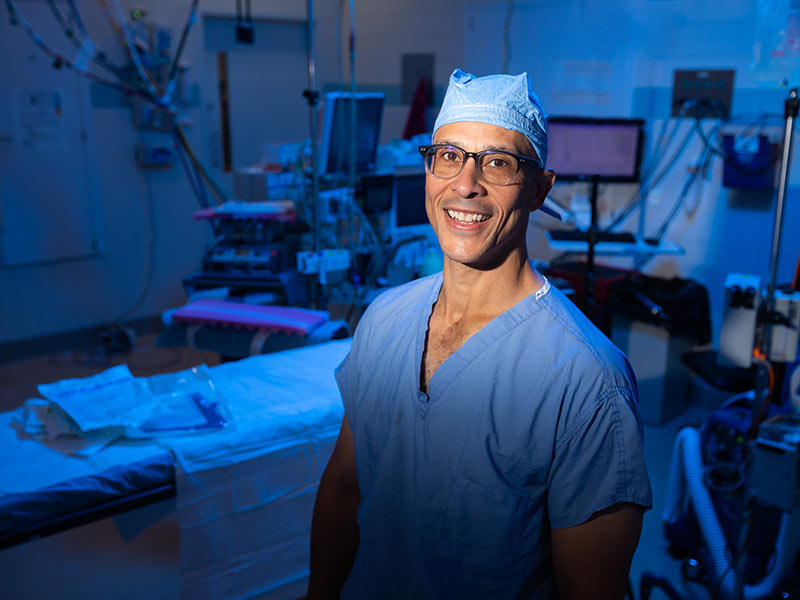
EDITOR’S NOTE: This article was originally published in the Winter 2020 edition of Mississippi Medicine, the medical alumni magazine.
If George Russell had not fallen out of a tree and discovered the gratifying world of fractures, the ranks of orthopaedic surgeons might be thinner today.
Because, around age 4 or 5, Russell (now known as Dr. George V. Russell Jr.) dropped out of a tree like an overripe peach and broke his elbow – the first in a series of broken bones mended by specialists whose skills would inspire a little boy to become a physician whose patients include people who fall out of trees.
“I always liked fractures,” said Russell, UMMC professor and James L. Hughes Chair of Orthopaedic Surgery. “To me as a kid, they seemed really cool. I just like moving the bones around. I like figuring out stuff.”
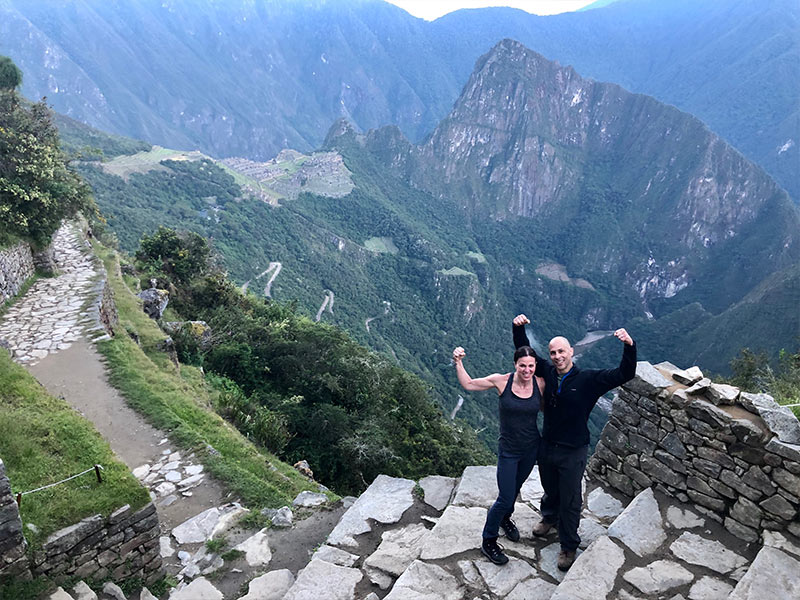
His wife of 10-plus years, Stephanie Russell goes further: “He’s always thinking. He’s very thoughtful about everything.”
Throughout his life, Russell, who turns 54 this month, has thought about and figured out a lot of things touching on his treatment of others, whether they are under the weather or under his wing, under the radar or under his roof.
TREE AND SYMPATHY
Born in Michigan, Russell was an infant when his family left for New York, not long before he broke his elbow; but Cincinnati is the place he considers home. That’s where he and his sister Lisa, now an attorney, mostly grew up, reared by Russell Sr. and their mom Patricia, or Pat, “the glue that held us together,” Russell said.
“I didn’t see much of my dad when I was growing up. We were never very close.
“He was in business and was gone from home a lot for work.” He died when Russell was a senior in high school, a public school that required a test for admission and where Russell played football for a year and “chess for fun,” he said.
Throughout his schooling, he said, “my parents pushed me and believed in me.”
He was 14 when his mom gave him the classic spy novel, “Shibumi.” “It was the first time I really fell in love with reading,” Russell said. That love endures. Today, he’s usually reading two or three books at a time, another sign that his mom’s influence is etched into the foundation of his everyday life.
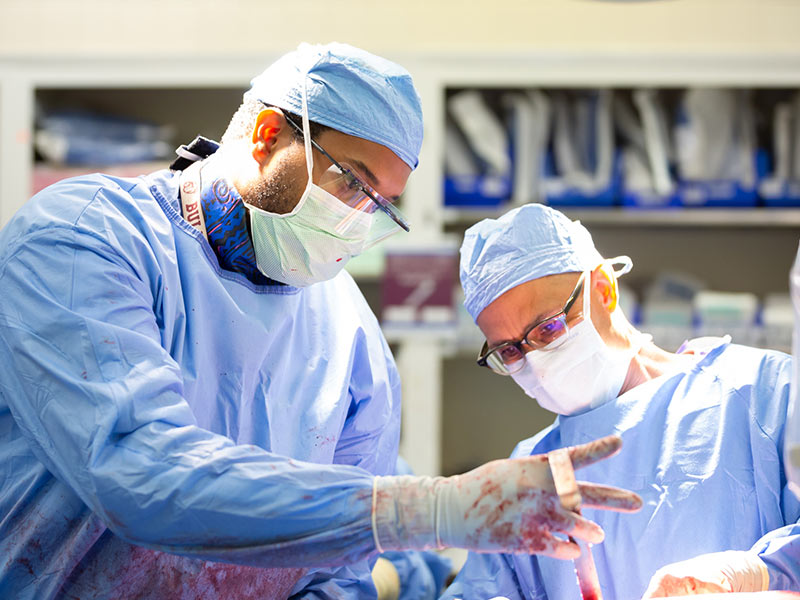
“She was affectionately known as ‘the warden,’” Russell said. “Our mom was a taskmaster, but serious about our best efforts to learn.”
Back in the era of segregation, she told her children, the only job options for her were in the post office or teaching.
“She wanted me to have a different mindset,” Russell said. “She taught me to dream big. Dream big and just see what happens. She kind of drove me to do my best. I’m not the smartest person in the world, by any means, but I will show up, just grind away and work hard.”
If she is his greatest font of inspiration, perhaps his second-greatest fell into his lap after Russell had been repeatedly felled by his injuries: Dr. Alvin Crawford.
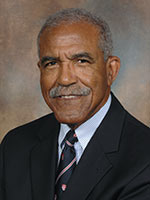
“Seeing an African American surgeon in the clinic was unusual for him,” said Crawford, a University of Cincinnati professor of orthopaedic surgery and an expert in spinal deformities and a genetic disorder often associated with scoliosis.
But it was Russell’s ankle, not his spine, which needed tending. “I believe that, over the years, he broke his ankle several times,” Crawford said.
He had. Russell, who was 10 when he first came to Crawford, would visit him a couple of times after that. He was 16 when Crawford operated on his right ankle, and spent his high school prom night in a hospital bed.
That wasn’t the last time Russell and the physician would see each other, though. Years later, Crawford would find his patient, not in his clinic, but in his classroom.
‘HAVING NEVER IMAGINED …’
“I had always wanted to be a doc, from the earliest age,” Russell said. “Dr. Crawford became my earliest mentor. I believe orthopaedics resonated with me because of the fractures. And the surgery.”
As a kid, Russell enjoyed dissecting the skills of B.J. Hunnicutt and “Hawkeye” Pierce, the fictional cutters from the TV series M*A*S*H*.
“It was cool looking at the blood and watching what they did,” he said. “It just seemed to be for me.”
Before he could get to medical school and the OR, he had to go through Denison University, a private liberal arts college in Granville, Ohio, boasting such alumni as William Rehnquist, Jennifer Garner, Steve Carell and Woody Hayes.
And George Russell; he graduated with a B.S. in 1988 and, 29 years later, in 2017, his alma mater awarded him the Alumni Citation – “the highest honor bestowed upon a Denisonian,” its Website says.
Accompanying the citation online is a biography with this phrase: “Having never imagined himself in Mississippi …”
“A ton of what you learn growing up is what you hear at the kitchen table – what’s important, what your expectations are,” Russell said.
“My parents grew up in segregated America, in Kentucky and West Virginia. I heard the stories about family members being bused to a high school 30 miles away; the nearest one was two miles away.
“Even with this adversity, getting an education is what you did. It was the family culture. My mom was one of 11 children. Her father finished the third grade. About eight of those 11 children went to college.
“For a black family to be able to do that at that time, especially in Kentucky and West Virginia, was remarkable. But race relations had not progressed nearly to the point we have today. For my parents, if you weren’t from the South, you just never considered moving down there.
“They said, ‘The place you don’t want to end up is Alabama or Mississippi.’”
THE CALMEST MANIAC
After Denison, Russell was admitted to the University of Cincinnati College of Medicine, eventually arriving, with his mended ankle, at the door of its mender.
“He became sort of a fixture in a post-clinic session for residents, reviewing patient’s X-rays,” Crawford said. “As a medical student, he didn’t have to do that.
“He attended conferences in the evening, when a medical student has other things to do. His work ethic was the thing that most impressed me. We gave him a few challenges, and he stood up to the test. As a result, we recommended him for acceptance into the orthopaedic residency program.”
Russell felt fortunate. “Orthopaedics is very competitive,” he said. And very demanding, as Crawford let him know.
“He accused me on many occasions of having kicked his butt a bit,” Crawford said. “But if he made up his mind to do something, he was like a duck taking to water. He was such a great resident.”
Russell’s research project received an award for best presentation; it was on pediatric scoliosis, one of Crawford’s fortes.
“But he let me know early on, that he was drawn to trauma,” Crawford said. Car crashes, deer stand disasters, off-road fiascos, tumbles from trees.
After Russell polished his skills with a fellowship at Harborview Medical Center in Seattle, he was called, of course, to the forbidden zone.
“The best opportunities to train further were in the South,” he said. In Mobile, a city still in the throes of desegregation when he was born, Russell was hired as an assistant professor of orthopaedic surgery at the University of South Alabama. Two years later, Mississippi beckoned.
“I thought to myself, ‘You’re an open-minded person,’” Russell said. “‘It’s a phenomenal opportunity; you need to try it.’”
Russell landed at UMMC in 2000, the year his mom died; what he had learned from her lived on.
“He just put his head down and worked like a maniac,” said Dr. Bob McGuire, professor of orthopaedic surgery and chair of the department at the time.
“And yet he has always shown the calmest demeanor. He’s been someone I can put my trust in, someone I know will do the right thing. And he is a superb teacher. When residents leave the program, they are absolutely equipped to handle any problem that comes along.”
It was Russell who helped sell at least one resident on UMMC. “He was very honest over the phone. Very down to earth,” said Dr. Randa Elmallah, a fourth-year orthopaedics resident.
“He makes a point to give us residents face time at least once a week, which is a big deal. And he makes a point to ask if we have any concerns. He has a very big emphasis on teaching. He will teach us a new topic every week, even if it’s not in his sub-specialty, which is trauma.”
Trauma comes in many guises. For some people, getting to work at 6 a.m. may be one. That’s what time Russell’s classes start.
“He is an early riser,” McGuire said. “And yet, he’s not always stuck in the hospital. He plays golf, he does CrossFit. He has a great relationship with his wife. He has balance in his life.”
In fact, if it weren’t for that back-breaking balance, he and Stephanie Russell might not have ever met.
A FILLED-UP LIFE
“Some people who have a midlife crisis buy cars; Ironman was my midlife crisis,” said Russell, who has completed Ironman triathlons in New Zealand and South Africa.
These days, he limits himself to golf and CrossFit – a sweaty routine of cycling, weightlifting, aerobics and other labors he and his wife share.
“I’d say I’m a little bit more competitive in CrossFit than he is,” Stephanie Russell said.
“I tried golf. I didn’t like it. But we have always enjoyed doing activities together. That’s how we met – riding bikes and doing triathlons.”
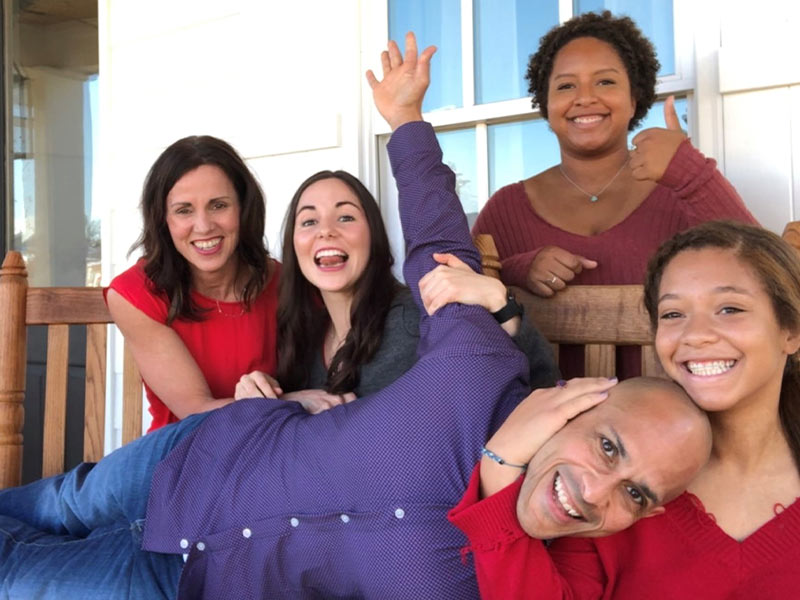
A full-time occupational therapist at UMMC for 25 years, Stephanie Russell now does PRN, or fill-in, duty in acute care OT at the University Medical Pavilion. She and her husband have a blended family. Stephanie’s daughter, Ivy, is 23. George Russell’s daughters are Kristen, also 22, and Jessica, 16, who lives with her mom in another state.
“He has high expectations for all of them,” Stephanie Russell said, “and they seem to meet them quite well. It’s been a pleasure to see him stay involved with all three girls. He has his own relationship with each of them.
“With all of us, he figures out how to make a lot of conflicting things work. You think, ‘There’s no way he can do all that,’ but he moves things around to make everyone happy. He puts everybody before himself.
“He’s a gift to all of us. He made me appreciate filling life up and the importance of being attentive to all of the things that are important to you.”
A little more than 10 years ago, they got married, and almost immediately, she said, her husband left for Chicago.
HERE’S THE THING
As his boss at the time knew, Russell’s pursuits are as brainy as they are brawny. Which, for Bob McGuire was a double-edged sword.
“Early on, I had said, ‘This is the guy I want to follow me,’” McGuire said. “I was all ready to retire as department chair. Then he told me he wanted to get an MBA.”
Not just any MBA, but one from the Kellogg School of Management at Northwestern University. That’s why Russell left for Chicago, albeit only every other weekend.
If he had to choose another career, Russell said, it would be “venture capitalist.” To satisfy his capitalistic itch, he lived what amounted to two lives, alternating between Mississippi and Illinois, between fractures and finance, month after month.
“It was a phenomenal experience,” Russell said “It taught me how business is really done. It’s about relationships. It is the antithesis of a medical education, at least when I was in medical school.
“It benefitted me in innumerable ways.” Not least of all, he said, it impressed on him the value of teamwork.
It took close to three years, until 2012, for Russell to conquer Kellogg. In the meantime, McGuire had delayed his retirement, but for a good cause, he said.
“Medicine was changing. It was becoming more of a corporate system. Having someone like George with an MBA would put the department in a good place.”
That place was going to be run by Russell, if McGuire had his way, and that way led to Dr. James Keeton (’65), the Medical Center’s leader at the time.
“George and I play golf together now,” said Keeton, vice chancellor emeritus for health affairs and dean emeritus of the School of Medicine. “But when Dr. McGuire came to me back then, I didn’t know George Russell at all.
“Some of the department’s faculty came to me begging me to hire him. And, boy, they turned out to be right.”
A spokesman for that group was Dr. Matthew Graves (’00), professor of orthopaedic surgery and the department’s vice chair.
“We’re lucky to have him here,” Graves said. “He has developed a love of this state and he has served it very well.
“Many of the patients would never have had surgery if he had not been here. And I can say I wouldn’t have stayed here after my residency if he had decided to leave.”
McGuire has also been a Russell rooter: “He’s well-respected, not only in the community, but also nationally.
“His claim to fame is doing pelvis and hip socket fractures on obese patients. That’s where he’s made a lot of inroads. A lot of people wouldn’t even touch those cases.”
As Russell put it: “My wife says I like to make life hard on myself.”
Pelvic surgery involves complex anatomy; vital structures surround the pelvic bone, he said. “It’s just hard.” As are hip socket repairs. And yet, these are his favorite surgeries.
“When you have an academic career,” he said, “you have to find your thing.” Consider morbid obesity with fractures: “These patients are much harder to treat. You can’t ask them to lose weight before surgery, because they their injury leaves them with little or no mobility,” Russell said.
“That’s my thing. It’s a challenge. So, I have developed an experience that most people will never have.” And, because of that experience, he has had the opportunity to “be creative,” he said.
That’s how he was able to come up with a brand-new procedure, its genesis tied up in a bedsheet rope.
THE LAST STOP
The idea for the clamshell osteotomy came to him from the case of a woman who tried to escape from an upper floor of a mental institution.
Her lifeline was a rope made from bedsheets, but it was too short. She broke her femur, which did not heal straight. Russell figured out a way to straighten it, and others like it.
His thought was to cut out a section of the crooked bone – that is, “split the femur, open it up like a clam, and put a rod through it.”
Compared with the procedure it replaced, this method for correcting crooked limbs “is a much simpler plan,” Russell said. “It uses a common technique – the placing of nails – which is the bread and butter of orthopaedic surgery and easy to teach.”
As his Denison citation notes: “[H]is creation of the clamshell osteotomy … has been utilized around the globe.”
It’s one more reason, McGuire said, that “it’s been fun for me to sit back and say, ‘This is the guy I picked.’”
Russell succeeded McGuire as chair in February 2013. In June 2014, he became the inaugural recipient of the endowed James L. Hughes Chair of Orthopaedic Surgery. He is the first African American to lead the department.
Graves, who joined the Medical Center in 2006, has tried to follow Russell’s lead, as a professional and as a person. “He is compassionate,” Graves said. “He takes care of problems that no one else will and no one else does. The patients love him. For some people in Mississippi, he is the last stop.”
One of Russell’s patients is Dylan Story, 14, of Pearl, who broke his arm in two places after being flipped off a side-by-side.
“He’s awesome,” said Dylan, who came to Russell on referral after surgery on a bone that at one time had been “basically dead.”
The referral came from Dr. Jaysson Brooks, who had inserted a rod in Dylan’s left arm, a limb now furrowed with scars from two more surgeries by Russell, including a bone graft from the patient’s leg.
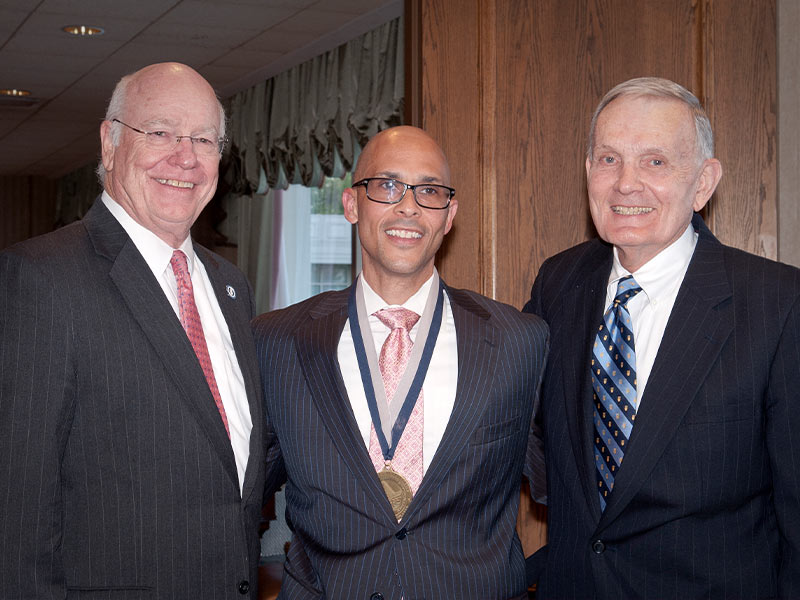
On a follow-up visit late last fall, Dylan showed Russell how he could bend the arm as if it had never been injured.
“Good. Very good,” Russell said. Then he explained why he would need to do another bone graft.
Jerry Smith, the teen’s father, listening closely, appeared satisfied with the explanation. Outside of Russell’s hearing, he said, “He speaks honestly, and in English, so we can understand him.”
That plain-spokenness is another trademark of the surgeon who stays here for the last-stop people, and the first-stops, for that matter. Despite his parents’ well-meant warning, he finds the people of this state to be “kind.”
“The thing I love about this place is that you really feel needed at the end of the day,” Russell said. “There is a need for compassionate care for people who don’t have a lot. It’s much more rewarding than I ever thought it would be.”
It has been rewarding for his mentor as well.
“He has achieved and exceeded more than you would ever dream one of your students would,” Crawford said. “I might have had something to do with it, but I was more of a cheerleader. This is something George did.”
Some years ago, Russell invited his former teacher to speak at a conference of orthopaedic surgeons. “That made me very proud,” Crawford said.
“That was the closest you can get to feeling like you are the father in a situation like that.”
In that sense, at least, Russell didn’t fall far from the tree after all.


